
Wine Culture and Information since 2002 - Volume 22
 Wine Culture and Information since 2002 - Volume 22 |
|
Issue 115, February 2013 |
Contents |
|
|
The Wine of Our Times |
|
Living our times it is something I certainly agree. It makes not much sense, at least to me, to be stuck in the past with the excuse that “the old times” were better than modern times. Maybe it is the simple admission of the incapability of growing up and the incapability of being able to accept that what it was cannot come back and will never come back. This does not mean - of course - that everything belonging to the past is to be denied or forgot: it would certainly be silly to not take advantage of our and others' experience, because, it is thank to that if we are here, for better or worse. Everyone, however, has the duty, as well as a moral duty towards oneself, to live his or her own time. This does not mean modern times are better than past times, but it is the only time of which we can be certain of, the one introducing us to the future, provided we have the chance to live that. There are good and bad things in modern times, as well as there have been good and bad things in past times. Time, after all, always goes by, for better or worse. This is true for every aspect of life and of everything belonging to our life, including wine. Modern times - the ones we are living now - certainly brought a huge benefits to wine, not only according to a enological and scientific point of view, but also according to a knowledge and cultural point of view. Thanks to the experience of the past, today we have a better knowledge about wine, not only from a chemical point of view, but also from a qualitative point of view, although the latter concept is, for many aspects, purely subjective. Modern times, I was saying, have immensely contributed to wine and its progress, moreover, to the spreading of news and the possibility to get information, to study, to understand. This aspect - undoubtedly - is an evident aspect of our times: the possibility to take advantage of many media and chances to get information, not only about wine, is one of the best conquests of present times. Modern communication media - in particular Internet - offer everyone the possibility, at least theoretically, to express one's own opinion and in a more or less free way. In communication media, like to say, of “classic style” - such as magazines, newspapers, radio and television - as well as in new media offered by technology, such as Internet and its many forms of application, it is a continuous flourishing of programs and initiatives about wine. In this terms, the phenomenon should be considered in positive terms. Talking about wine, to keep high the interest for the beverage of Bacchus, certainly contributes to the spreading of its culture, something renewing in every era, including our era. However, all that glitters is not gold. For the sake of truth, however there also are many cases of real gold. Let's clear this: whoever is using a communication media in order to promote and spread the culture of wine, in every form and way, has all of my appreciation and support. After all - something which is not understood by many - we are all working for the same goal and result, some more, some less and for what he or she can, for the promotion and the spreading of wine culture. Every initiative about communication and related to wine, is useful to the same cause, also in case we do not agree on what has been spoken or supported. Of course, I do not mean everything must be saved, including arrogance, incompetence and haughtiness. I am afraid - and according to what I see, it is something likely to happen - wine is about to become a “frivolous” object of the show business, a way to affirm a supposed, but however evidently non existing, competence or knowledge, in particular in those communication media making use of visuals as a primary way of spreading, such as television and pictures published on magazine and Internet. In fact, most of the times, they try to support with images, created with an incredible and efficient effect, the evident lack of competence and professionalism, leaving to words - which are and will always be important - a marginal role, while focusing on the explicit effect of an image. Too frequently are heard - as well as read - opinions having no real or technical foundation, words certainly detrimental to wine and to the ones listening to it, even with a good faith. For example, we could consider what happened to the world of cooking after it has been a popular subject in most of television shows. It is not important that the person put in the show - who, in most of the cases, is not a chef and it is evident the complete ignorance about cooking techniques and the most elementary knowledge about food - what really counts is what is being shown. From this point of view, it is very sad, in fact, that the skill and talent of a chef is mainly evaluated according to the appearance of the dish: a sad and pathetic show of food pornography, which result is better achieved with the help of a good photographer or director. Cooking is not the real subject of the show, they do not have a real interest about the educational aspect of this subject - like to say - they are focused to the show only, to the suggestion of the explicit. This could be justified by saying that a television show has its own times and one must follow them. Well, this means television is better suited to fast food instead of real cooking, something which is not made of images only, but in particular of technique, competence, professionalism and time. And it is also a matter of morality and ethics. I believe wine has been saved from wine pornography, only because the image of a glass of wine - besides being repetitive, despite its endless colors and aspects - is not as much as attractive as a dish aesthetically prepared with a more or less artistic way. Modern communication media however offer wine lovers many possibilities, maybe more than what it can be offered to cooking, while allowing - in the limit of what can be done - a more concrete information. In particular, the possibilities offered by Internet, a sort of mare magnum (literally, big sea) of information, in which can be virtually found everything. All that glitters is not gold: right. It is however undeniable that thanks to the Internet, has been created a place for sharing opinions and ideas, something giving everyone, like to say, the chance to get information and to take part to the information. Everyone can contribute, in his or her own way and for what he or she can, to the promotion of wine culture, a heritage belonging to all of us and to our civilization. We all - and not only those who write about wine, either for a job or pleasure - should remember this aspect, instead of competing against each other, having arguments about everything and wasting time, like to say, in splitting hairs. Antonello Biancalana
|
||||
Tasting: More Than a TechniqueSensorial tasting is made of techniques forcing the taster to do the job according to specific criteria. Technique, however, is not everything |
|
Sensorial testing is a very important practice for knowing and understanding wine. A concept already expressed in the past in these pages, something reasserted again in this occasion. This does not mean the appreciation of a wine can be done by the strict practice of tasting only, as appreciation - in its many forms - is, after all, a purely subjective matter. A wine can certainly be appreciated in informal and friendly occasions as well, in company of friends while enjoying the occasion and the moment itself, of course, provided this is done in moderation and never with a shameful abuse. When a wine is being evaluated according to the sensorial tasting technique, in an analytic and critical way, it is however fundamental to abandon the emotional state typical in informal and friendly situations. A fundamental condition is in fact a state of isolation from any external factor which could disturb concentration and attention towards the content of the glass. Sensorial tasting is, with no doubt, the use and application of specific methods and techniques in order to evaluate and determine the characteristics and quality of a wine. It should be considered that sensorial evaluation is not a discipline concerning wine only, but any element - therefore not only food and beverages - having the property of stimulating senses, every type of sense. The practice of sensorial tasting, although it is mainly made of technical factors, it is not based on the analysis of the elements involved in the definition and constitution of the result only. Technique, every technique, requires three specific conditions in order to be useful and to give concrete and tangible results. First of all, it is necessary to know the technique, the factors and the methods making it, therefore - a fundamental step - it is required to understand it. Understanding a technique therefore implies the condition of having proper requirements and competences allowing the learning and understanding. After having learnt and understood the technique, in its theoretical form, it is indispensable to have the capability of rendering the theoretical concept in its practical form, that is the capacity of knowing how to use the concepts according to the real circumstance of use. For example, as for wine, gustatory evaluation technique is based on the same theoretical principles, however their application differs according to the style of wine to be evaluated. The evaluation and determination of balance, for example, radically changes in case of a white wine or a red wine. Finally, the capability of knowing how to determine results and, therefore, knowing how to understand and interpret the result in order to get consistent and defined information and reference models. The latter aspect, representing, as a matter of fact, the primary goal of a technique and its use, allows not only the definition and evaluation of the sample to be examined, but also - and in particular - the possibility to compare it with other samples in order to determine differences and peculiarities of each of them. Learning and understanding a technique, like already said, is done thanks to the preliminary knowledge of the elements to which the technique refers to. In other words, in order to understand arithmetic and mathematics, it is indispensable to know what numbers are. Likewise, in order to taste a wine in a profitable way, it is indispensable to know what is wine, what are the elements and conditions involved in production and, not less important, how it is produced. Knowing how to taste a wine does not mean being a wine maker, vintner or agronomist, likewise, being a wine maker, vintner or agronomist does not mean being a taster. It is however indispensable for a wine maker to know the techniques of wine sensorial tasting - his job is, after all, about making the fundamental element of the tasting - and it certainly is not indispensable for a taster to be a wine maker. These roles evidently have different goals, but it is however undeniable that a good taster must have the knowledge, a good knowledge, about wine making and viticulture.
However, sensorial tasting is not a practice in which improvisation, even worse, superficiality, can bring to reliable results, it is however undeniable curiosity, an innate predisposition and talent, are elements of remarkable value. If it is true in order to profitably understand and use the techniques of sensorial tasting it is fundamental the knowledge of wine and its production, likewise it is equally important to know the tools allowing its application, such as the glass and the organs of sense. Besides this, it is also fundamental to understand the role of physical and environmental factors strongly influencing the perception of each stimulus, such as, for example, temperature of wine and environment. A red wine, tasted at a temperature of 10 °C, will bring to a result very different from the same tasting done at a temperature of 18 °C. The result is also affected by the specific qualities of wine, such as astringency, acidity and alcohol. The practice of sensorial tasting unavoidably requires the knowledge and understanding of other disciplines and competences. It is not enough to know the techniques to be used, one must - among the other things - know, and not superficially, the physiology of taste and senses, the characteristics of grapes, the role of environment and viticultural conditions, viticultural and wine making techniques and how they can affect production in function of all the other elements. For example, the same grape can produce extremely different results according to the place and condition in which it has been cultivated, viticultural methods used during the course of the season, meteorological conditions and, last but not the least, how the grapes have been processed during production. Cabernet Sauvignon, a grape known for making wine of good structure and with deep and intense colors, can also make wines of medium body, with a pale color and high transparency, in case it was cultivated in wrong places and with high yields. The study of auxiliary matters related to enology and viticulture - in any case to be considered as fundamental - are of extreme importance for every taster. Understanding the quality and characteristics of a territory and its grapes, has in the practice of sensorial tasting, its primary application of study. Likewise, this is equally important for every discipline related to wine: by using sensorial tasting it is possible to test and evaluate different cultural and wine making techniques, including environmental, ampelographic and meteorological conditions. This latter aspect, has its maximum efficiency in comparative sensorial tasting, by comparing wines produced with the same grapes but cultivated and produced in different territories. Likewise, it is extremely useful to compare wines of the same producer and belonging to different vintages, as well as a wine of the same vintage and belonging to the same territory, but produced by different wineries. The two latter examples, are respectively defined vertical tasting and horizontal tasting. To these should also be added - for the sake of completeness - the so called diagonal tasting, consisting in the comparative evaluation of wines belonging to the same style and territory, but produced in different vintages and different producers. Diagonal tasting, as a matter of fact, does not offer concrete chances of study, as the differences of elements making the wines, style and territory apart, do not allow the definition of a consistent model of study. The practice and usefulness of comparative tasting - despite of its type - is in any case beneficial and profitable for the study and preliminary knowledge of the characteristic elements of the wine to be tasted. In other words, in case the wines to be compared are all produced with grapes cultivated in sandy soils, the color observed in the glass will be paler than the same grape cultivated in clay soil. Time and practice give the taster an invaluable tool, something going beyond the understanding and usage of techniques. Among them, two factors are particularly useful and fundamental in order to do a profitable tasting: memory and experience. In both cases, their development is not favored, like to say, by a purely theoretical study of the matters, but by a practice done with commitment and in a profitable way. To continuously exercising our skills by practicing sensorial tasting is - as a matter of fact - the most important aspect in order to acquire new elements useful to improve our experience and knowledge. Experience and knowledge are presuppositions requiring a good memory: practicing without learning - therefore, remembering - what has been done and what has been perceived in a wine, makes the tasting useless for our education and skill. For this reason, invaluable allies of the taster are paper and pen. Taking notes of all the tasting done, what has been perceived, comments and thoughts about the sensorial evaluation and how each element interacts with others, will allow the taster to develop a proper and invaluable historical memory. Taking note of our impressions and sensations perceived during the tasting, it is not however the only type of memory beneficial to the taster. There is in fact a type of memory that, for its nature, cannot take full advantage of writing and words: sensorial memory and, in particular, olfactory memory. Remembering an aroma, a smell, and being capable to quickly associate it with a specific wine, or a territory, grape, wine making technique or environment, represents a remarkable tool for every taster. This capability is obtained both by a personal talent, but also - and in particular - by practice and training, last but not the least, by a good level of concentration. Concentration is a fundamental condition in order to get the best advantage from sensorial tasting, not only for the understanding of techniques and the improvement of the knowledge about the wine to be evaluated, but also, in particular, for the determination of a reliable and useful result. For this reason, the profitable practice of sensorial tasting provides for the adoption of environmental conditions in order to favor the concentration without interferences or disturbing elements. Concentration is obtained, besides by favorable environmental conditions, by the taster's mental condition, by a relaxed condition, while trying to not allow our thoughts - negative and positive as well - to influence the evaluation and, therefore, the reliability of the job. Likewise, the presence of disturbing sensorial elements, such as perfumes and smell in the tasting room, making use of perfumes, having recently consumed food or beverages, all represent elements of disturb, not only for the concentration and the perception of sensorial stimuli. Every taster, with time and practice, develops his or her own personal methods and strategies, in order to make the work of tasting the most profitable possible. Each phase of tasting, besides using technique, is also done by adopting a very personal method of job, in particular for the evaluation and recognition of wine aromas. In this sense, the awareness of the elements identified in the appearance analysis, allow the taster to use methods and strategies for each wine style. By seeing a red wine, for example, the taster will use a different analytic approach than the one used for white or sparkling wines. The most complex phase of sensorial tasting certainly is olfactory evaluation, besides being the most interesting one. Having a strategy for the recognition of aromas - including memory - allows to do the job in a short time. For example, it is more profitable to start by identifying the family to which the olfactory stimulus belongs to - such as flowers, fruits, vegetables or tertiary aromas - instead of concentrating on the recognition of a specific aroma. The same is also true for gustatory analysis and for taste-olfactory correspondence.
|
||||||||||||
Wines of the Month |
|
|
|
Score legend Prices are to be considered as indicative. Prices may vary according to the country or the shop where wines are bought |
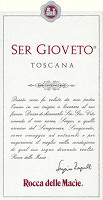
|
|
Ser Gioveto 2009 |
|
| Rocca delle Macie (Tuscany, Italy) | |
| Grapes: Sangiovese (80%), Cabernet Sauvignon, Merlot (20%) | |
| Price: € 27.00 | Score: |
| Ser Gioveto shows an intense ruby red color and nuances of garnet red, little transparency. The nose denotes intense, clean, pleasing and refined aromas that start with hints of black cherry, plum and black currant followed by aromas of violet, blueberry, vanilla, cocoa, tobacco, mace and eucalyptus. The mouth has good correspondence to the nose, a tannic attack and however balanced by alcohol, good body, intense flavors, agreeable. The finish is persistent with flavors of black cherry, plum and black currant. Ser Gioveto ages for about 14 months in barrique followed by 9 months of aging in bottle. | |
| Food Match: Roasted meat, Braised and stewed meat, Hard cheese | |
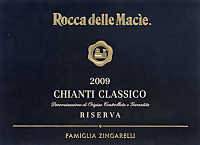
|
|
Chianti Classico Riserva 2009 |
|
| Rocca delle Macie (Tuscany, Italy) | |
| Grapes: Sangiovese (90%), Cabernet Sauvignon (5%), Merlot (5%) | |
| Price: € 19.00 | Score: |
| Chianti Classico Riserva shows a brilliant ruby red color and nuances of ruby red, little transparency. The nose denotes intense, clean, pleasing, refined and elegant which start with hints of black cherry, blackberry and black currant followed by aromas of violet, plum, blueberry, vanilla, chocolate, cinnamon, tobacco and menthol. The mouth has good correspondence to the nose, a properly tannic attack and however balanced by alcohol, good body, intense flavors, agreeable. The finish is persistent with flavors of black cherry, plum and black currant. Chianti Classico Riserva ages for about two years in cask followed by at least 3 months of aging in bottle. | |
| Food Match: Broiled meat and barbecue, Roasted meat, Stewed and braised meat with mushrooms | |
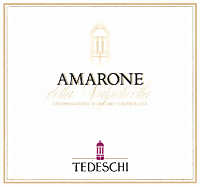
|
|
Amarone della Valpolicella Classico 2008 |
|
| Tedeschi (Veneto, Italy) | |
| Grapes: Corvina (30%), Corvinone (30%), Rondinella (30%), Oseleta, Negrara, Dindarella, Rossignola (10%) | |
| Price: € 30.00 | Score: |
| This Amarone della Valpolicella Classico shows an intense ruby red color and nuances of garnet red, little transparency. The nose reveals intense, clean, pleasing, refined and elegant aromas which start with hints of blackberry, black cherry and dried violet followed by aromas of plum, blueberry, vanilla, tobacco, chocolate, leather, mace, pink pepper and menthol. The mouth has good correspondence to the nose, a tannic attack and however balanced by alcohol, full body, intense flavors, pleasing roundness. The finish is persistent with flavors of blackberry, plum and black cherry. This Amarone della Valpolicella Classico ages in cask for 3 years followed by 6 months of aging in bottle. | |
| Food Match: Game, Stewed and braised meat, Roasted meat, Hard cheese | |
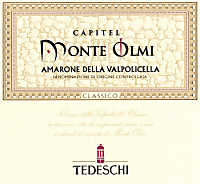
|
|
Amarone della Valpolicella Classico Capitel Monte Olmi 2007 |
|
| Tedeschi (Veneto, Italy) | |
| Grapes: Corvina (30%), Corvinone (30%), Rondinella (30%), Oseleta, Negrara, Dindarella, Croatina, Forselina (10%) | |
| Price: € 55.00 | Score: |
| Amarone della Valpolicella Classico Capitel Monte Olmi shows a deep ruby red color and nuances of garnet red, little transparency. The nose reveals intense, clean, pleasing, refined and elegant aromas which start with hints of blackberry, black cherry and dried violet followed by aromas of plum, cherries in alcohol, blueberry, vanilla, chocolate, tobacco, leather, mace and menthol. The mouth has excellent correspondence to the nose, a tannic attack and however balanced by alcohol, full body, intense flavors, pleasing roundness. The finish is very persistent with long flavors of blackberry, black cherry and plum. Amarone della Valpolicella Classico Capitel Monte Olmi ages for about 3 years in cask followed by 6 months of aging in bottle. | |
| Food Match: Game, Stewed and braised meat, Roasted meat, Hard cheese | |
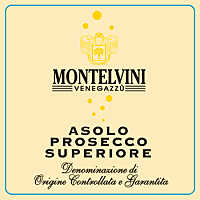
|
|
Asolo Prosecco Superiore Extra Dry 2011 |
|
| Montelvini (Veneto, Italy) | |
| Grapes: Glera | |
| Price: € 9.20 | Score: |
| Asolo Prosecco Superiore Extra Dry shows an intense greenish yellow color and nuances of greenish yellow, very transparent, fine and persistent perlage. The nose reveals intense, clean, pleasing and refined aromas which start with hints of apple, hawthorn and wistaria followed by aromas of apple, pear, pineapple, peach, broom and plum. The mouth has good correspondence to the nose, an effervescent attack and pleasing sweetness, however balanced by alcohol, good body, intense flavors, pleasing crispness. The finish is persistent with flavors of apple, pear and peach. Asolo Prosecco Superiore Extra Dry referments in closed tank for 2 months. | |
| Food Match: Aperitifs, Vegetable appetizers, Vegetable flans, Risotto with vegetable and crustaceans | |
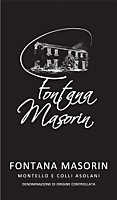
|
|
Montello e Colli Asolani Rosso Fontana Masorin 2006 |
|
| Montelvini (Veneto, Italy) | |
| Grapes: Merlot (60%), Cabernet Franc (20%), Cabernet Sauvignon (20%) | |
| Price: € 9.20 | Score: |
| Montello e Colli Asolani Rosso Fontana Masorin shows an intense ruby red color and nuances of garnet red, little transparency. The nose denotes intense, clean, pleasing and refined aromas which start with hints of plum, black currant and black cherry followed by aromas of blueberry, dried violet, vanilla, tobacco, leather, licorice and chocolate. The mouth has good correspondence to the nose, a properly tannic attack and however balanced by alcohol, good body, intense flavors, pleasing roundness. The finish is persistent with flavors of plum, black currant and black cherry. Montello e Colli Asolani Rosso Fontana Masorin ages for 18 months in barrique followed by 18 months of aging in bottle. | |
| Food Match: Roasted meat, Stewed and braised meat, Hard cheese | |
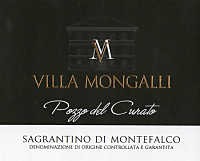
|
|
Sagrantino di Montefalco Pozzo del Curato 2004 |
|
| Villa Mongalli (Umbria, Italy) | |
| Grapes: Sagrantino | |
| Price: € 21.00 | Score: |
| Sagrantino di Montefalco Pozzo del Curato shows an intense ruby red color and nuances of garnet red, little transparency. The nose reveals intense, clean, pleasing, refined and elegant aromas which start with hints of blackberry, plum and dried violet followed by aromas of black cherry, blueberry, vanilla, tobacco, chocolate, mace and menthol. The mouth has good correspondence to the nose, a tannic attack and however balanced by alcohol, full body, intense flavors, agreeable. The finish is persistent with flavors of blackberry, plum and black cherry. Sagrantino di Montefalco Pozzo del Curato ages for 12 months in barrique followed by 30 months of aging in bottle. | |
| Food Match: Game, Roasted meat, Stewed and braised meat, Hard cheese | |
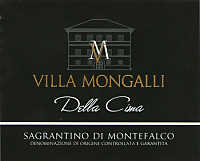
|
|
Sagrantino di Montefalco Della Cima 2004 |
|
| Villa Mongalli (Umbria, Italy) | |
| Grapes: Sagrantino | |
| Price: € 31.50 | Score: |
| Sagrantino di Montefalco Della Cima shows a deep ruby red color and nuances of garnet red, little transparency. The nose reveals intense, clean, pleasing, refined and elegant aromas which start with hints of blackberry, black cherry and dried violet followed by aromas of plum, vanilla, chocolate, licorice, tobacco, blueberry, leather, mace, cinnamon and menthol. The mouth has excellent correspondence to the nose, a tannic attack and however balanced by alcohol, full body, intense flavors, pleasing roundness. The finish is very persistent with long flavors of blackberry, plum and black cherry. Sagrantino di Montefalco Della Cima ages for 24 months in barrique followed by 36 months of aging in bottle. | |
| Food Match: Game, Roasted meat, Stewed and braised meat, Hard cheese | |
News |
|
In this section are published news and information about events concerning the world of wine and food. Whoever is interested in publishing this kind of information can send us a mail to our address.
|
AquavitaeReview of Grappa, Distillates and Brandy |
|
|
| Distillates are rated according to DiWineTaste's evaluation method. Please see score legend in the "Wines of the Month" section. |
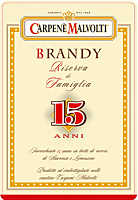
|
|
Brandy Riserva di Famiglia 15 Anni |
|
| Carpenè Malvolti (Veneto, Italy) | |
| Raw matter: Selection of Wine | |
| Price: € 29.00 - 70cl | Score: |
| Brandy Riserva di Famiglia 15 Anni shows a deep amber yellow color, limpid and crystalline. The nose denotes intense, clean, pleasing and refined aromas of dried fig, cocoa, hazelnut, vanilla, praline, tobacco, honey, prune and licorice, with almost imperceptible alcohol pungency. In the mouth has intense flavors and with perceptible alcohol pungency which tends to dissolve rapidly, good correspondence to the nose, pleasing roundness. The finish is persistent with flavors of honey, praline, prune and cocoa. This brandy ages for at least 15 years in small Slavonian and Limousine oak barrels. | |
Wine Parade |
|
|
| The best 15 wines according to DiWineTaste's readers. To express your best three wines send us an E-mail or fill in the form available at our WEB site. |
| Rank | Wine, Producer | |
|---|---|---|
| 1 |
| Franciacorta Pas Dosé Récemment Dégorgé 2006, Cavalleri (Italy) |
| 2 |
| Sagrantino di Montefalco Collepiano 2007, Arnaldo Caprai (Italy) |
| 3 |
| Avvoltore 2009, Moris Farms (Italy) |
| 4 |
| Adarmando 2009, Tabarrini (Italy) |
| 5 |
| Trento Talento Brut Riserva 2007, Letrari (Italy) |
| 6 |
| Batàr 2008, Querciabella (Italy) |
| 7 |
| Gran Masetto 2007, Endrizzi (Italy) |
| 8 |
| San Leonardo 2006, Tenuta San Leonardo (Italy) |
| 9 |
| Confini 2007, Lis Neris (Italy) |
| 10 |
| Trento Brut Riserva Methius 2006, Dorigati (Italy) |
| 11 |
| Collio Sauvignon Ronco delle Mele 2010, Venica (Italy) |
| 12 |
| Camartina 2008, Querciabella (Italy) |
| 13 |
| Brunello di Montalcino 2006, Siro Pacenti (Italy) |
| 14 |
| Brunello di Montalcino 2007, Donatella Cinelli Colombini (Italy) |
| 15 |
| Verdicchio dei Castelli di Jesi Classico Superiore Podium 2010, Garofoli (Italy) |
| |||||||
Privacy Policy | |||||||


| Copyright © 2002-2024 Antonello Biancalana, DiWineTaste - All rights reserved |
| All rights reserved under international copyright conventions. No part of this publication and of this WEB site may be
reproduced or utilized in any form or by any means, electronic or mechanical, without permission in writing from DiWineTaste. |